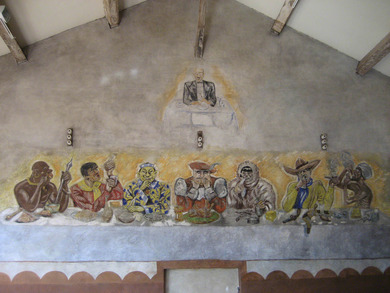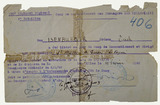Internment camp at Les Milles
Chère Jeanne, S.O.S. Max
Postcard from Max Ernst to the gallery-owner Jeanne Bucher, 1 September 1939
After World War II broke out, the French government ordered that Germans and Austrians living in France be interned. Many of them had fled from Nazi Germany because of racist or political persecution to find refuge in their neighbouring country, where they were now seen as “enemy aliens”.
Most of the internment camps were only provisional set-ups like the brickworks in Les Milles near Aix-en-Provence. After the outbreak of war, more than 1,500 internees were kept there with insufficient sanitary facilities and not enough supplies. Hygiene conditions there were catastrophic. The prisoners also included famous artists like the writers Lion Feuchtwanger, Walter Hasenclever, Alfred Kantorowicz and Golo Mann as well as the painters Max Ernst and Hans Bellmer. Almost all of the internees were released at the beginning of 1940, however, when the German army once again attacked France, prisoners were brought to Les Milles again. Until its closure in the late autumn of 1942, around 10,000 from 27 countries had been kept there.
Building measures brought hardly any improvement to the living conditions. The internees tried to brighten up their dreary days by organising cultural events. A studio was set up for the around 40 painters there and they decorated the walls of the guards’ canteen with murals in a joint effort.
Les Milles was the only transit camp in France and prisoners who possessed the required papers were allowed to leave the country. In March 1941, an office of the Jewish refugee organisation HICEM was opened in the brickworks and some managed, with the help of American aid organisations like the Emergency Rescue Committee, to get to the USA. The camp was cordoned off in August 1942 as the Vichy Regime, which collaborated with Germany, had agreed to deport Jewish internees without French papers. Around 2,000 children, women and men were taken forcibly from Les Milles via the transit camp in Drancy by Paris to the extermination camp in Auschwitz.
Further reading:
Obschernitzki, Doris: Letzte Hoffnung – Ausreise. Die Ziegelei von Les Milles 1939-1942. Vom Lager für unerwünschte Ausländer zum Deportationszentrum. Teetz: Hentrich und Hentrich 1999
Gausmann, Angelika: Deutschsprachige bildende Künstler im Internierungs- und Deportationslager Les Milles von 1939 bis 1942. Paderborn: Möllmann 1997



